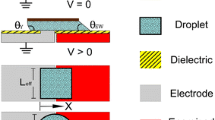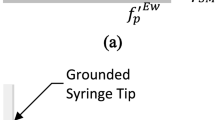Abstract
We numerically analyze the AC electric field around a droplet placed on an insulator-covered electrode. The time-averaged effective electrical wetting tension, which is a function of AC frequency, is computed by integrating the Maxwell stress. The computed wetting tension is compared with the experimental result converted from the separately obtained contact-angle data. There is a good agreement between the two results at a low-frequency range and a qualitative agreement at a high-frequency range. Interestingly, the numerical results show that the electric-field strength decreases remarkably in the insulating layer near the TCL as the AC frequency increases. This decrease may account for the delay of the dielectric breakdown of an insulating layer in the AC case, which could be related to the contact-angle saturation phenomenon.












Similar content being viewed by others
References
Berge B, Peseux J (2000) Variable focal lens controlled by an external voltage: an application of electrowetting. Eur Phys J E 3(2):159–163
Berim GO, Ruckenstein E (2005) Microscopic interpretation of the dependence of the contact angle on roughness. Langmuir 21(17):7743–7751
Bienia M, Vallade M, Quilliet C, Mugele F (2006) Electrical-field-induced curvature increase on a drop of conducting liquid. Europhys Lett 74(1):103–106
Blake TD, Clarke A, Stattersfield EH (2000) An investigation of electrostatic assist in dynamic wetting. Langmuir 16(6):2928–2935
Buehrle J, Herminghaus S, Mugele F (2003) Interface profiles near three-phase contact lines in electric fields. Phys Rev Lett 91(8):086101
Cho SK, Moon HJ, Kim CJ (2003) Creating, transporting, cutting, and merging liquid droplets by electrowetting-based actuation for digital microfluidic circuits. J Microelectromech Syst 12(1):70–80
Haus HA, Melcher JR (1989). Electromagnetic fields and energy. Prentice Hall, Englewood Cliffs
Hayes RA, Feenstra BJ (2003) Video-speed electronic paper based on electrowetting. Nature 425(6956):383–385
Jackson JD (1999). Classical electrodynamics. Wiley, Hoboken
Jones TB (2002) On the relationship of dielectrophoresis and electrowetting. Langmuir 18(11):4437–4443
Jones TB, Fowler JD, Chang YS, Kim CJ (2003) Frequency-based relationship of electrowetting and dielectrophoretic liquid microactuation. Langmuir 19(18):7646–7651
Jones TB, Wang KL, Yao DJ (2004) Frequency-dependent electromechanics of aqueous liquids: electrowetting and dielectrophoresis. Langmuir 20(7):2813–2818
Kang KH (2002) How electrostatic fields change contact angle in electrowetting. Langmuir 18(26):10318–10322
Kang KH, Kang IS, Lee CM (2003) Wetting tension due to Coulombic interaction in charge-related wetting phenomena. Langmuir 19(13):5407–5412
Kedzierski J, Berry S (2006) Engineering the electrocapillary behavior of electrolyte droplets on thin fluoropolymer films. Langmuir 22(13):5690–5696
Ko SH, Lee H, Kang KH (2007) Hydrodynamic flows in electrowetting. Langmuir (in press)
Kuiper S, Hendriks BHW (2004) Variable-focus liquid lens for miniature cameras. Appl Phys Lett 85(7):1128–1130
Kumar A, Pluntke M, Cross B, Baret JC, Mugele F (2006) Finite conductivity effects and apparent contact angle saturation in AC electrowetting. Mater Res Soc Symp Proc 0899-N06-01.1–0899-N06-01.8
Mugele F, Baret JC (2005) Electrowetting: from basics to applications. J Phys Condens Matter 17(28):R705–R774
Mugele F, Baret JC, Steinhauser D (2006) Microfluidic mixing through electrowetting-induced droplet oscillations. Appl Phys Lett 88:204106
Papathanasiou AG, Boudouvis AG (2005) Manifestation of the connection between dielectric breakdown strength and contact angle saturation in electrowetting. Appl Phys Lett 86:164102
Peykov V, Quinn A, Ralston J (2000) Electrowetting: a model for contact-angle saturation. Colloid Polym Sci 278(8):789–793
Quilliet C, Berge B (2001) Electrowetting: a recent outbreak. Curr Opin Colloid Interface Sci 6(1):34–39
Quinn A, Sedev R, Ralston J (2005) Contact angle saturation in electrowetting. J Phys Chem B 109(13):6268–6275
Seyrat E, Hayes RA (2001) Amorphous fluoropolymers as insulators for reversible low-voltage electrowetting. J Appl Phys 90(3):1383–1386
Shapiro B, Moon H, Garrell RL, Kim CJ (2003) Equilibrium behavior of sessile drops under surface tension, applied external fields, and material variations. J Appl Phys 93(9):5794–5811
Vallet M, Berge B, Vovelle L (1996) Electrowetting of water and aqueous solutions on poly(ethylene terephthalate) insulating films. Polymer 37(12):2465–2470
Vallet M, Vallade M, Berge B (1999) Limiting phenomena for the spreading of water on polymer films by electrowetting. Eur Phys J B 11(4):583–591
Verheijen HJJ, Prins MWJ (1999) Reversible electrowetting and trapping of charge: model and experiments. Langmuir 15(20):6616–6620
Zeng J, Korsmeyer T (2004) Principles of droplet electrohydrodynamics for lab-on-a-chip. Lab Chip 4(4):265–277
Acknowledgments
This work was funded by Center for Ultramicrochemical Process Systems sponsored by KOSEF. This work was also supported by the grant R01-2001-00410 from KOSEF and the grant by BK21 program of Ministry of Education of Korea. The authors greatly acknowledge the financial support.
Author information
Authors and Affiliations
Corresponding authors
Appendices
Appendix 1: Time average of the Maxwell stress and the RMS electric-field strength
There is the following time-average theorem for the two time-harmonic complex variables of \( u = \text{Re} \{ \ifmmode\expandafter\tilde\else\expandafter\sim \fi{u}e{}^{{j\omega t}}\} \) and \( v = \text{Re} \{ \ifmmode\expandafter\tilde\else\expandafter\sim \fi{v}e{}^{{j\omega t}}\} \) (Jackson 1999):
Here, the bracket \( {\left\langle {\text{ }} \right\rangle } \) denotes the time average and the superscript ‘*’ a complex conjugate. The directional vectors are time-independent, so that the time average of the electrical stress in r-direction in Eq. (8) can be rewritten as
The time average of the Maxwell stress tensor becomes from Eq. (10),
The complex electric field is decomposed as \( {{\tilde{\bf{E}}}} = \ifmmode\expandafter\tilde\else\expandafter\sim \fi{E}_{r} {\mathbf{e}}_{r} + \ifmmode\expandafter\tilde\else\expandafter\sim \fi{E}_{z} {\mathbf{e}}_{z} \) which is substituted into Eq. (12) to obtain
The time-averaged Maxwell stress in Eq. (13) is substituted to Eq. (11) and normal vector is decomposed as n = n r e r+n z e z . Then the following result is obtained:
Similarly, the RMS electric-field strength becomes
Appendix 2: Average value of the Maxwell stress just below the TCL
We introduce the control surface Σ = S∪S 1∪S 2···S 5 as shown in Fig. 13. Here, S denotes the surface used to obtain the average value in the numerical analysis. The conservation of electromagnetic momentum condition for the domain enclosed by Σ is written as follows (Kang et al. 2003):
Here, n the outward normal vector for each surface. By using Eq. (16), one can calculate the force exerted on the surface S from the sum of the forces acting on other surfaces, that is,
The average force acting on S can be also expressed as follows:
It is quite clear the electric fields on the surfaces S 1, S 3 and S 5, which are nonzero contributions, have well-defined finite values. In conclusion, the average stress near the TCL is finite and then the average electric field is also finite.
Rights and permissions
About this article
Cite this article
Hong, J.S., Ko, S.H., Kang, K.H. et al. A numerical investigation on AC electrowetting of a droplet. Microfluid Nanofluid 5, 263–271 (2008). https://doi.org/10.1007/s10404-007-0246-4
Received:
Accepted:
Published:
Issue Date:
DOI: https://doi.org/10.1007/s10404-007-0246-4





